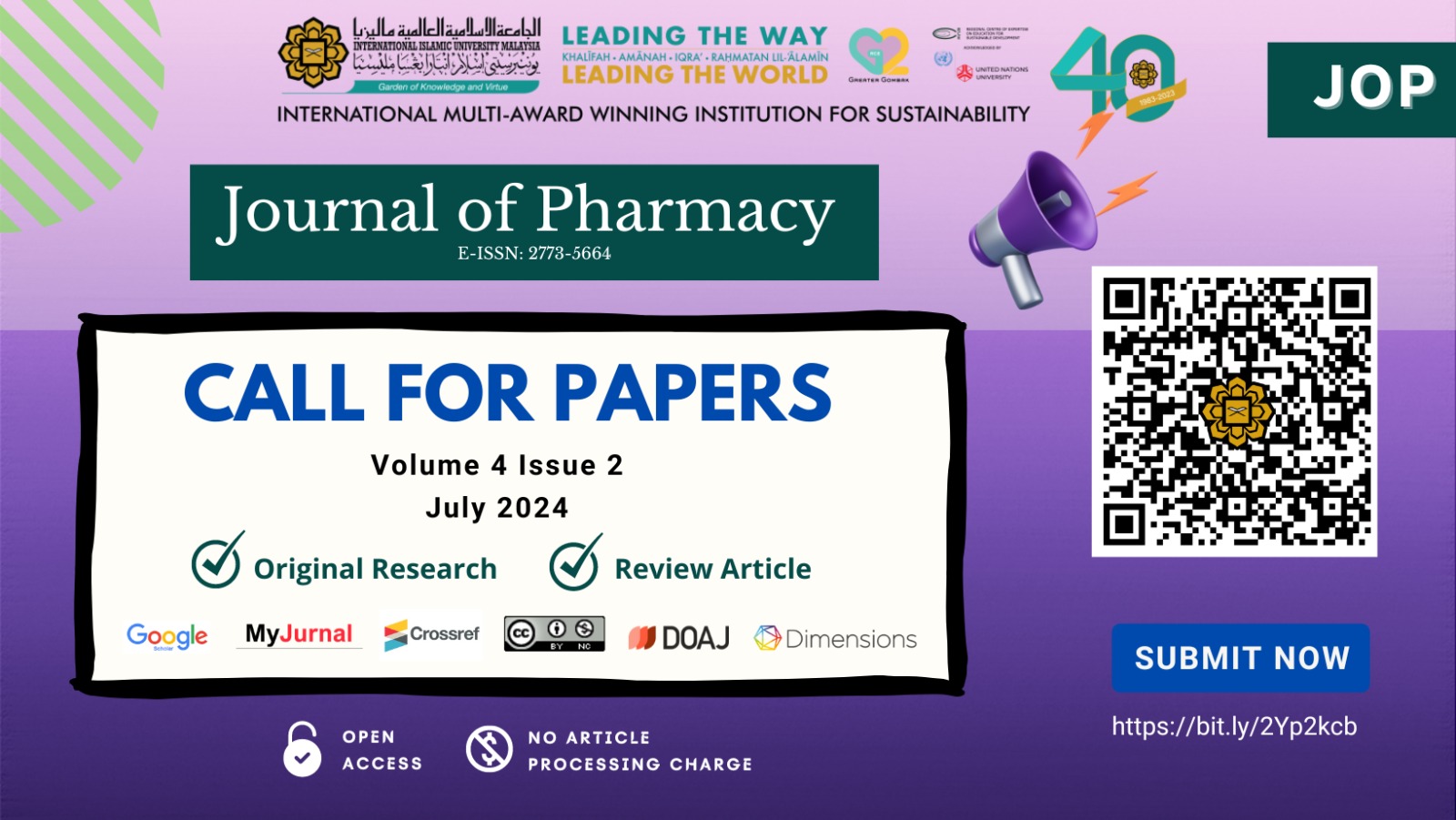Types and Costs of Medications Returned by Outpatients at a Malaysian Teaching Hospital: A One-Year Cross-Sectional Study.
DOI:
https://doi.org/10.31436/jop.v2i2.150Keywords:
cost, returned medications, types, outpatients, factorsAbstract
Introduction: Medication wastage is attributable to various factors, including therapeutic failure, over-prescription, and poor compliance. Data regarding the cost and types of returned medications are essential to estimate the financial burden that can be reduced locally through targeted intervention. This study aimed to investigate the types and cost of medications returned by outpatients at a teaching hospital in Kuantan, Pahang.
Materials and methods: This cross-sectional study collected data from the electronic medical record based on the list of returned medications at the outpatient pharmacy department at Sultan Ahmad Shah medical Centre (SASMEC)@IIUM between January and December 2021. All medications with SASMEC patients' label were included. The medications were classified according to the classification index based on the British National Formulary. The data were analysed using Microsoft Excel version 16.52. The cost associated with returned medications was calculated, referring to the latest cost price of the respective medications.
Results: A total of 134 patients returned their medications in 2021 (mean ± SD age: 63 ± 13 years), with 52% females. The total quantities of returned medications were 11,054 units. These included pills, devices (inhalers, insulin pens), bottles, and plastic containers. The overall cost of these medications was Ringgit Malaysia (RM) 13,594.90 (mean per patient: RM 101.45). The highest number of returned medications was from the cardiovascular group (32.5%), followed by the endocrine group (26%) and musculoskeletal group (11.9%). The highest cost for returned medications was the endocrine group (49%), followed by the cardiovascular group (20%) and the musculoskeletal group (10%).
Conclusion: Medications used for cardiovascular diseases were the most frequently returned at outpatient pharmacy, whereas those for endocrine diseases contributed to the highest cost. Future research could focus on identifying modifiable factors that can contribute to the sustainability of health resources by reducing the cost of returned medications.
References
Al-Siyabi, K., & Al-Riyami, K. (2007). Value and types of medicines returned by patients to Sultan Qaboos University Hospital pharmacy, Oman. Sultan Qaboos University Medical Journal, 7(2), 109–115. Retrieved from https://journals.squ.edu.om/index.php/squmj/index
Aitken, M., Kleinrock, M., Lyle, J., Nass, D., & Caskey, L. (2014). Global Outlook for Medicines Through 2018. IMS Institute for Healthcare Informatics, November, 42. Retrieved from http://www.imshealth.com/
Alhamad, H., Patel, N., & Donyai, P. (2017). How do people conceptualise the reuse of medicines? An interview study. International Journal of Pharmacy Practice, 26(3), 232–241. https://doi.org/doi: 10.1111/ijpp.12391
Ali, S E, & Ibrahim, M. I. M. (2009). Extent of Medication Wastage and Cost among Female Students in a University Setting. Mahidol University Journal of Pharmaceutical Science, 36(1–4), 34–43. Retrieved from https://pharmacy.mahidol.ac.th/journal/
Alnahas, F., Yeboah, P., Fliedel, L., Abdin, A. Y., & Alhareth, K. (2020). Expired medication: Societal, regulatory and ethical aspects of a wasted opportunity. International Journal of Environmental Research and Public Health, 17(3). https://doi.org/10.3390/ijerph17030787
Arkaravichien, W., Ruchipiyarak, T., Thawinwan, W., & Benjawilaikul, S. (2014). A Threat to the Environment from Practice of Drug Disposal in Thailand. EnvironmentAsia, 7(1), 13–18.
Aziz, H., Hatah, E., Makmor-Bakry, M., Islahudin, F., Ahmad Hamdi, N., & Mok Pok Wan, I. (2018). A comparison of medication adherence between subsidised and self-paying patients in Malaysia. Malaysian Family Physician, 13(2), 2–9. Retrived from https://e-mfp.org
Batavia, A. S., Balaji, K., Houle, E., Parisaboina, S., Ganesh, A. K., Mayer, K. H., & Solomon, S. (2010). Adherence to antiretroviral therapy in patients participating in a graduated cost recovery program at an HIV care center in South India. AIDS and Behavior, 14(4), 794–798. https://doi.org/10.1007/s10461-009-9663-6
Bettington, E., Spinks, J., Kelly, F., & Wheeler, A. J. (2018). Returning unwanted medicines to pharmacies: Prescribing to reduce waste. Australian Prescriber, 41(3), 78–81. https://doi.org/10.18773/austprescr.2018.015
Bicket, M. C., Long, J. J., Pronovost, P. J., Alexander, G. C., & Wu, C. L. (2017). Prescription opioid analgesics commonly unused after surgery: A systematic review. JAMA Surgery, 152(11), 1066–1071. https://doi.org/10.1001/jamasurg.2017.0831
Chiatti, C., Bustacchini, S., Furneri, G., Mantovani, L., Cristiani, M., Misuraca, C., & Lattanzio, F. (2012). The economic burden of inappropriate drug prescribing, lack of adherence and compliance, adverse drug events in older people a systematic review. Drug Safety, 35(SUPPL. 1), 73–87. https://doi.org/10.1007/BF03319105
Chou, R., Gordon, D. B., De Leon-Casasola, O. A., Rosenberg, J. M., Bickler, S., Brennan, T., . . . Wu, C. L. (2016). Management of postoperative pain: A clinical practice guideline from the American pain society, the American society of regional anesthesia and pain medicine, and the American society of anesthesiologists' committee on regional anesthesia, executive committee, and administrative council. Journal of Pain, 17(2), 131–157. https://doi.org/10.1016/j.jpain.2015.12.008
Ebrahim, A. J., Teni, F. S., & Yimenu, D. K. (2019). Unused and Expired Medications: Are They a Threat? A Facility-Based Cross-Sectional Study. Journal of Primary Care and Community Health, 10, 1–11. https://doi.org/10.1177/2150132719847857
El-Hamamsy, M. (2011). Unused Medications: How Cost and How Disposal of in Cairo, Egypt. International Journal of Pharmaceutical Studies and Research, 16(I), 21–27. Retrieved from http://technicaljournalsonline.com/ijpsr/
Elnaem, M. H., Irwan, N. A., Abubakar, U., Sulaiman, S. A. S., Elrggal, M. E., & Cheema, E. (2020). Impact of medication regimen simplification on medication adherence and clinical outcomes in patients with long-term medical conditions. Patient Preference and Adherence, 14, 2135–2145. https://doi.org/10.2147/PPA.S268499
Fabbiani, M., Zaccarelli, M., Grima, P., Prosperi, M., Fanti, I., Colafigli, M., D’Avino, A., Mondi, A., Borghetti, A., Fantoni, M., Cauda, R., & Di Giambenedetto, S. (2014). Single tablet regimens are associated with reduced Efavirenz withdrawal in antiretroviral therapy naïve or switching for simplification HIV-infected patients. BMC Infectious Diseases, 14(1), 1–7. https://doi.org/10.1186/1471-2334-14-26
Ghinea, N., Lipworth, W., & Kerridge, I. (2016). Propaganda or the cost of innovation? Challenging the high price of new drugs. BMJ (Online), 352(March 2016), 2–5. https://doi.org/10.1136/bmj.i1284
Guirguis, K. (2010). Medications collected for disposal by outreach pharmacists in Australia. Pharmacy World and Science, 32(1), 52–58. https://doi.org/10.1007/s11096-009-9340-x
Hassali, M. A., & Shakeel, S. (2020). Unused and Expired Medications Disposal Practices among the General Public in Selangor, Malaysia. Pharmacy, 8(4), 196. https://doi.org/10.3390/pharmacy8040196
Hassali, M. A., Supian, A., Ibrahim, M. I., Al-Qazaz, H. K., Al-Haddad, M., Salee, F., & Palaian, S. (2012). The Characteristics of Drug Wastage at The Hospital, Tuanku Jaafar Seremban, Malaysia: A descriptive study. Journal of Clinical and Diagnostic Research, 6(5), 787–790. Retrieved from https://www.scimagojr.com/journalsearch.php?q=16400154778&tip=sid
Hernández Arroyo, M. J., Cabrera Figueroa, S. E., Sepúlveda Correa, R., Valverde Merino, M. P., Luna Rodrigo, G., & Domínguez-Gil Hurlé, A. (2016). Influence of The Number of Daily Pills and Doses on Adherence to Antiretroviral Treatment: A 7-year study. Journal of Clinical Pharmacy and Therapeutics, 41(1), 34–39. https://doi.org/10.1111/jcpt.12343
Ibrahim MIM, Awang R, Razak DA. (1997). A drug wastage and utilisation study: A preliminary community project. International Conferences on Improving Use of Medicines 1997. Retrieved from https://www.isium.org/conference-proceedings-icium/
Jörgensen, T., Johansson, S., Kennerfalk, A., Wallander, M. A., & Svärdsudd, K. K. (2001). Prescription drug use, diagnoses, and healthcare utilization among the elderly. Annals of Pharmacotherapy, 35(9), 1004–1009. https://doi.org/10.1345/aph.10351
Kuna, P., Creemers, J. P. H. M., Vondra, V., Black, P. N., Lindqvist, A., Nihlen, U., & Vogelmeier, C. (2006). Once-daily dosing with budesonide/formoterol compared with twice-daily budesonide/formoterol and once-daily budesonide in adults with mild to moderate asthma. Respiratory Medicine, 100(12), 2151–2159. https://doi.org/10.1016/j.rmed.2006.03.016
Laliberte, F., Bookhart, B. K., Nelson, W. W., Lefebvre, P., Schein, J. R., Rondeau-Leclaire, J., & Duh, M. S. (2013). Impact of once-daily versus twice-daily dosing frequency on adherence to chronic medications among patients with venous thromboembolism. Patient, 6(3), 213–224. https://doi.org/10.1007/s40271-013-0020-5
Ma, A., Chen, D. M., Chau, F. M., & Saberi, P. (2010). Improving adherence and clinical outcomes through an HIV pharmacist’s interventions. AIDS Care - Psychological and Socio-Medical Aspects of AIDS/HIV, 22(10), 1189–1194. https://doi.org/10.1080/09540121003668102
Matsuda, S. (2019). Health Policy in Japan – Current Situation and Future Challenges. JMA Journal, 2(1), 1–10. https://doi.org/10.31662/jmaj.2018-0016
Morgan, T. M. (2001). The Economic Impact of Wasted Prescription Medication in an Outpatient Population of Older Adults. Journal of Family Practice 50(9), 779– 781. Retrieved from https://www.frontlinemedcom.com/brands-posts/the-journal-of-family-practice/
National Institutes of Health. (2016). World's older population grows dramatically. Retrieved from https://www.nih.gov/news-events/news-releases/worlds-older-population-grows-dramatically
Newman, C. B., Preiss, D., Tobert, J. A., Jacobson, T. A., Page, R. L., Goldstein, L. B., . . .Welty, F. K. (2019). Statin Safety and Associated Adverse Events A Scientific Statement from the American Heart Association. In Arteriosclerosis, Thrombosis, and Vascular Biology 39(2). E38-E81. https://doi.org/10.1161/ATV.0000000000000073
Nurolaini, K. (2016). Medication Wastage and its Disposal Amongst Patients at Suri Seri Begawan Hospital in Brunei Darussalam. Medicine & Health (Universiti Kebangsaan Malaysia), 11(2), 139. Retrieved from https://www.medicineandhealthukm.com
Oh, C. K., Bang, J. B., Kim, S. J., Huh, K. H., Kim, S. J., Jeon, J. S., Han, S. Y., Cho, H. R., Kwon, Y. J., Lee, S. H., & Kim, Y. S. (2020). Improvement of Medication Adherence with Simplified Once-daily Immunosuppressive Regimen in Stable Kidney Transplant Recipients: A prospective cohort study. Asian Journal of Surgery, 43(6), 660–667. https://doi.org/10.1016/j.asjsur.2019.07.011
Ong, S. C., Ooi, G. S., Shafie, A. A., & Hassali, M. A. (2020). Knowledge, attitude and disposing practice of unused and expired medicines among the general public in Malaysia. Journal of Pharmaceutical Health Services Research, 11(2), 141–148. https://doi.org/10.1111/jphs.12333
Paes, A. H. P., & Barker, A. (1997). Impact of Dosage Frequency on Patient Compliance. Clinical Care Education Nutrition, 20(10). http://doi.org/ 10.2337/diacare.20.10.1512
Rahim, R. (2016). Ministry destroys RM2mil worth of expired meds. Retrieved from https://www.thestar.com.my/news/nation/2016/12/27/ministry-destroys-rm2mil-worth-of-expired-meds
Roca, B., Lapuebla, C., & Vidal-Tegedor, B. (2005). HAART with didanosine once versus twice daily: Adherence and efficacy. International Journal of Infectious Diseases, 9(4), 195–200. https://doi.org/10.1016/j.ijid.2004.07.006
Rubio, R., Serrano, O., Carmena, J., Asensi, V., Echevarría, S., Flores, J., . . . González-García, J. (2010). Effect of Simplification from Protease Inhibitors to Boosted Atazanavir-Based Regimens in Real-Life Conditions. HIV Medicine, 11(9), 545–553. https://doi.org/10.1111/j.1468-1293.2010.00827.x
Sim, S. M., Lai, P. S. M., Tan, K. M., Lee, H. G., & Sulaiman, C. Z. (2018). Development and Validation of the Return and Disposal of Unused Medications Questionnaire (ReDiUM) in Malaysia. Asia-Pacific Journal of Public Health, 30(8), 737–749. https://doi.org/10.1177/1010539518811161
Smale, E. M., Egberts, T. C. G., Heerdink, E. R., van den Bemt, B. J. F., & Bekker, C. L. (2021). Waste-minimising measures to achieve sustainable supply and use of medication. Sustainable Chemistry and Pharmacy, 20(2021), 100400. https://doi.org/10.1016/j.scp.2021.100400
Times of Malta. (2012). Returned Unused Medicines are "Tip of The Iceberg." Retrieved from https://timesofmalta.com/articles/view/returned-unused-medicines-are-tip-of-the-iceberg.414136
Trueman, P., Lowson, K., Blighe, A., & Meszaros, A. (2011). Evaluation of the Scale, Causes and Costs of Waste Medicines Evaluation of the Scale, Causes and Costs of Waste Medicines. York Health Economics Consortium, 17, 327–349. http://evi.sagepub.com/cgi/doi/10.1177/1356389011421697
Ueki, T., Sanematsu, E., Kawano, S., Nakamura, Y., Kawamichi, N., Shinohara, Y., Yatera, K., & Tanaka, F. (2022). Medication Wastage in a University Hospital in Japan. Biological and Pharmaceutical Bulletin, 45(1), 118–123. https://doi.org/10.1248/bpb.b21-00761
Watkinson, A. J., & Costanzo, S. D. (2017). Antimicrobials and Antimicrobial Resistant Bacteria in Australia. Antimicrobial Resistance in Wastewater Treatment Processes, 109–127. https://doi.org/10.1002/9781119192428.ch7
West, L. M., Diack, L., Stewart, D., & Cordina, M. (2015). Applying the Delphi Technique to Define "Medication Wastage." European Journal of Hospital Pharmacy, 22(5), 274–279. https://doi.org/10.1136/ejhpharm-2014-000593
Wheeler, A. J., Kelly, F., Spinks, J., & Bettington, E. (2016). National Return and Disposal of Unwanted Medicines Project Audit 2016: Final Report. Brisbane: Griffith University, November, 2016. Retrieved from https://returnmed.com.au/wp-content/uploads/2017/08/NatRUM-Project-Final-Report-Griffith-University.pdf
Wijekoon, C. N., Samarawickrama, M. T., Mendis, G. S. C., Wanigasuriya, J. K. P., & Wijekoon, P. W. M. C. S. B. (2020). Factors Associated With Uncontrolled Hypertension in Patients Attending a Medical Clinic of A Tertiary Care Hospital in Sri Lanka. Journal of the Ceylon College of Physicians, 51(2), 96. https://doi.org/10.4038/jccp.v51i2.7903
Wouters, H., Van Dijk, L., Geers, H. C. J., Winters, N. A., Van Geffen, E. C. G., Stiggelbout, A. M., & Bouvy, M. L. (2016). Understanding Statin Non-Adherence: Knowing Which Perceptions and Experiences Matter to Different Patients. PLoS ONE, 11(1), 1–12. https://doi.org/10.1371/journal.pone.0146272
Downloads
Published
How to Cite
Issue
Section
License
Copyright (c) 2022 IIUM Press

This work is licensed under a Creative Commons Attribution 4.0 International License.
Journal of Pharmacy at https://journals.iium.edu.my/ktn/index.php/jp is licensed under a Creative Commons Attribution 4.0 International License.












